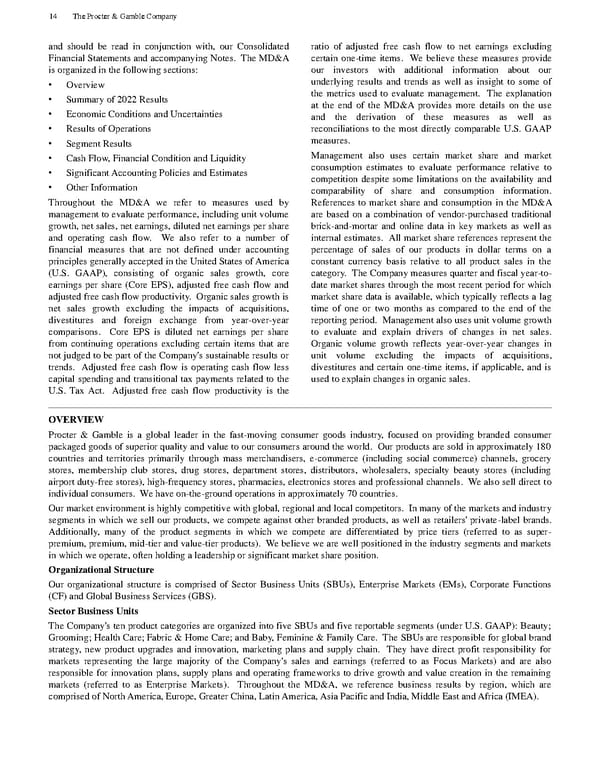and should be read in conjunction with, our Consolidated Financial Statements and accompanying Notes. The MD&A is organized in the following sections: • Overview • Summary of 2022 Results • Economic Conditions and Uncertainties • Results of Operations • Segment Results • Cash Flow, Financial Condition and Liquidity • Significant Accounting Policies and Estimates • Other Information Throughout the MD&A we refer to measures used by management to evaluate performance, including unit volume growth, net sales, net earnings, diluted net earnings per share and operati ng cash flow. We also refer to a number of financial measures that are not defined under accounting principles generally accepted in the United States of America (U.S. GAAP), consisting of organic sales growth, core earnings per share (Core EPS), adjusted free cash flow and adjusted free cash flow productivity. Organic sales growth is net sales growth excluding the impacts of acquisitions, divestitures and foreign exchange from year - over - year comparisons. Core EPS is diluted net earnings per share from c ontinuing operations excluding certain items that are not judged to be part of the Company's sustainable results or trends. Adjusted free cash flow is operating cash flow less capital spending and transitional tax payments related to the U.S. Tax Act. Ad justed free cash flow productivity is the ratio of adjusted free cash flow to net earnings excluding certain one - time items. We believe these m easures provide our investors with additional information about our underlying results and trends as well as insight to some of the metrics used to evaluate management. The explanation at the end of the MD&A provides more details on the use and the derivation of these measures as well as reconciliations to the most directly comparable U.S. GAAP measures. Managem ent also uses certain market share and market consumption estimates to evaluate performance relative to competition despite some limitations on the availability and comparability of share and consumption information. References to market share and consump tion in the MD&A are based on a combination of vendor - purchased traditional brick - and - mortar and online data in key markets as well as internal estimates. All market share references represent the percentage of sales of our products in dollar terms on a c onstant currency basis relative to all product sales in the category. The Company measures quarter and fiscal year - to - date market shares through the most recent period for which market share data is available, which typically reflects a lag time of one or two months as compared to the end of the reporting period. Management also uses unit volume growth to evaluate and explain drivers of changes in net sales. Organic volume growth reflects year - over - year changes in unit volume excluding the impacts of acq uisitions, divestitures and certain one - time items, if applicable, and is used to explain changes in organic sales. OVERVIEW Procter & Gamble is a global leader in the fast - moving consumer goods industry, focused on providing brande d consumer packaged goods of superior quality and value to our consumers around the world. Our products are sold in approximately 180 countries and territories primarily through mass merchandisers, e - commerce (including social commerce) channels, grocery stores, membership club stores, drug stores, department stores, distributors, wholesalers, specialty beauty stores (including airport duty - free stores), high - frequency stores, pharmacies, electronics stores and professional channels. We also sell direct t o individual consumers. We have on - the - ground operations in approximately 70 countries. Our market environment is highly competitive with global, regional and local competitors. In many of the markets and industr y segments in which we sell our products, we compete against other branded products, as well as retailers' private - label brands. Additionally, many of the product segments in which we compete are differentiated by price tiers (referred to as super - premium, premium, mid - tier and value - tier product s). We believe we are well positioned in the industry segments and markets in which we operate, often holding a leadership or significant market share position. Organizational Structure Our organizational structure is comprised of Sector Business Units (S BUs), Enterprise Markets (EMs), Corporate Functions (CF) and Global Business Services (GBS). Sector Business Units The Company's ten product categories are organized into five SBUs and five reportable segments (under U.S. GAAP): Beauty; Grooming; Health Ca re; Fabric & Home Care; and Baby, Feminine & Family Care. The SBUs are responsible for global brand strategy, new product upgrades and innovation, marketing plans and supply chain. They have direct profit responsibility for markets representing the large majority of the Company's sales and earnings (referred to as Focus Markets) and are also responsible for innovation plans, supply plans and operating frameworks to drive growth and value creation in the remaining markets (referred to as Enterprise Markets ). Throughout the MD&A, we reference business results by region, which are comprised of North America, Europe, Greater China, Latin America, Asia Pacific and India, Middle East and Africa (IMEA). 14 The Procter & Gamble Company
 The Procter & Gamble Annual Report Page 25 Page 27
The Procter & Gamble Annual Report Page 25 Page 27